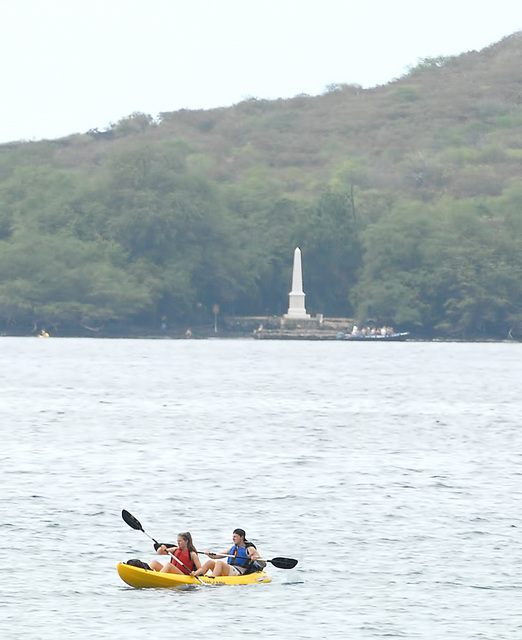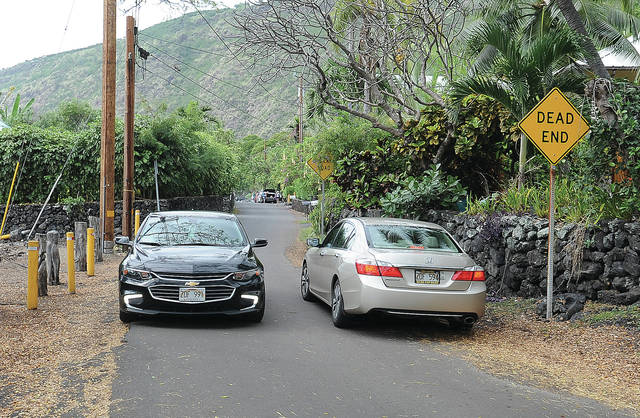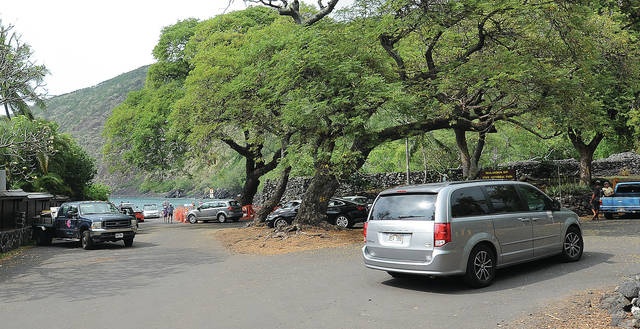KAILUA-KONA — Several residents who spoke out about a draft environmental impact statement connected to a master plan at Kealakekua Bay State Historical Park said many of the document’s elements don’t pass muster.
“If I turned this in to my school, they would have given me an ‘incomplete,’” said Tony Casciato, summing up the biological resource survey report, which assessed plants and animals at the park site.
Casciato referenced the endangered species in the bay area, such as the Hawaiian hoary bat. The survey says the chances of any adverse impacts to bats “are likely small,” but, Casciato noted, the resources survey explicitly states that “surveys for Hawaiian hoary bats were not conducted.”
And while he agreed with plans to restore native habitats and control invasive species, he said, the means to accomplish those ends must be made clear.
Casciato was one of about five dozen people to attend a public comment meeting for the draft environmental impact statement connected to the master plan for Kealakekua Bay State Historical Park, a South Kona site the state Department of Land and Natural Resources and the Division of State Parks have been trying to develop for decades.
Curt Cottrell, administrator for the Division of State Parks, said he wanted attendees to come away with some closure on the planning process that involves what he said is one of the most iconic parks in the state culturally and for natural resources.
Social media, he said, is driving more and more visitors to the area, so it’s crucial to develop a way to mitigate the impact of people and ensure adequate infrastructure.
“I don’t think we can turn the clock back, but I think we need to establish a filter of the tourists that’s balanced with the community values of this historic place,” he said. “We want to keep it as it is now, but with a little bit better infrastructure.”
The draft document, put together by Belt Collins Hawaii LLC, includes several recommendations intended to increase access and facilities as well as improve safety all while preserving and maintaining the area’s natural and cultural resources.
Those initial costs would include a new entry, parking lot and interpretive center at the park’s Napoopoo section as well as a waterless toilet, signage, shelter and a landing zone at Kaawaloa.
Capital improvements would come with a price tag of less than $2.4 million, with annual operational costs around half a million dollars once the full plan is in place.
One of the key elements, Cottrell said, will be managing watercraft in the bay, adding that effort will probably involve partnering with some entity at Napoopoo landing.
“We’re trying to make Kealakekua Bay more resilient to use, but not increase it,” he said. “And do a better job of just telling the story.”
But from biological resources to cultural impact and traffic analysis, many who testified on the draft said, it just isn’t good enough.
Conall Kahakaio Ravenscraft testified about the breadth of cultural practices perpetuated in the area near Kealakekua Bay and well beyond the park’s boundaries — practices, he said, that aren’t adequately noted and explored in the cultural impact assessment portion of the draft environmental impact statement.
“Right now, the way these materials are presented to us, it looks like the state of Hawaii Department of Land and Natural Resources Division of State Parks fails to acknowledge the very existence of these stories and these lifestyles, as if to say that we don’t even exist,” he said. “We do exist. We’re here.”
Ravenscraft also commented on inaccuracies others had identified in the draft environmental impact statement, saying that those errors “creates a level of mistrust” when the document includes wrong information.
“So clearly, more work needs to be done there,” he said.
Some attendees called on a cultural advisory group to be organized immediately.
The draft environmental impact statement says such a group “should be established before any more effort being put into a master plan.”
Robert Flatt, who provided West Hawaii Today with testimony he submitted in advance to the governor, said the draft statement was “800 pages of lipstick on a pig.”
Much of Flatt’s criticism of the proposal is directed at the document’s transportation impact analysis and proposed solutions to potential impacts to traffic in the area.
Flatt, for example, challenged the document’s assumption of how many visitors would get to the park via Napoopoo Road as opposed to Puuhonua Road.
The transportation impact analysis estimates the project will generate 28 new weekday trips during peak hours and 36 new trips during Saturday peak hours. And the vast majority of traffic the project generates, the document expects, would come to and leave the site via the intersection of Mamalahoa Highway and Napoopoo Road.
It’s likely, the document said, that “a few” of the trips, estimated at 15 percent, would come from or go to Puuhonua Road, which runs between the Kealakekua Bay site and Puuhonua o Honaunau National Historical Park. The rest are expected to use Napoopoo Road to access the state park.
Flatt said that assumption “is probably wrong.”
“It is reasonable to assume that visitors to one historical park will also visit another historical park 4 miles away,” he said.
The public comment period for the draft environmental impact statement ends April 23.
A PDF of the document is available at https://bit.ly/2pHsEtp.
Email Cameron Miculka at cmiculka@westhawaiitoday.com.











